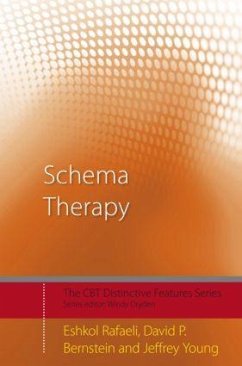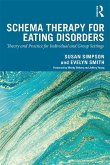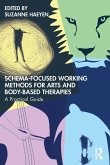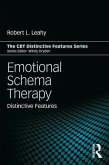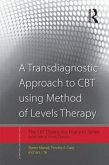Eshkol Rafaeli (Columbia University, New York, USA and Bar-Ilan Uni, David P. Bernstein (Faculty of Psychology, Maastricht University, T, Jeffrey Young (Department of Psychiatry, Columbia University, New Y
Schema Therapy
Distinctive Features
Eshkol Rafaeli (Columbia University, New York, USA and Bar-Ilan Uni, David P. Bernstein (Faculty of Psychology, Maastricht University, T, Jeffrey Young (Department of Psychiatry, Columbia University, New Y
Schema Therapy
Distinctive Features
- Broschiertes Buch
- Merkliste
- Auf die Merkliste
- Bewerten Bewerten
- Teilen
- Produkt teilen
- Produkterinnerung
- Produkterinnerung
In this book, Eshkol Rafaeli, David P. Bernstein and Jeffrey Young à â â pioneers of the Schema Therapy approach à â â indicate the 30 distinctive features of Schema Therapy, and how the method fits into the broader CBT spectrum.
Andere Kunden interessierten sich auch für
![Schema Therapy for Eating Disorders Schema Therapy for Eating Disorders]() Schema Therapy for Eating Disorders31,99 €
Schema Therapy for Eating Disorders31,99 €![Cognitive Behavioural Chairwork Cognitive Behavioural Chairwork]() Matthew PughCognitive Behavioural Chairwork20,99 €
Matthew PughCognitive Behavioural Chairwork20,99 €![Schema-Focused Working Methods for Arts and Body-Based Therapies Schema-Focused Working Methods for Arts and Body-Based Therapies]() Schema-Focused Working Methods for Arts and Body-Based Therapies78,99 €
Schema-Focused Working Methods for Arts and Body-Based Therapies78,99 €![Emotional Schema Therapy Emotional Schema Therapy]() Robert L. LeahyEmotional Schema Therapy20,99 €
Robert L. LeahyEmotional Schema Therapy20,99 €![A Transdiagnostic Approach to CBT Using Method of Levels Therapy A Transdiagnostic Approach to CBT Using Method of Levels Therapy]() Warren Mansell (UK University of Manchester)A Transdiagnostic Approach to CBT Using Method of Levels Therapy45,99 €
Warren Mansell (UK University of Manchester)A Transdiagnostic Approach to CBT Using Method of Levels Therapy45,99 €![Moving On After Trauma Moving On After Trauma]() Michael J. ScottMoving On After Trauma24,99 €
Michael J. ScottMoving On After Trauma24,99 €![Core Clinical Competencies in Counseling and Psychotherapy Core Clinical Competencies in Counseling and Psychotherapy]() Len SperryCore Clinical Competencies in Counseling and Psychotherapy46,99 €
Len SperryCore Clinical Competencies in Counseling and Psychotherapy46,99 €-
-
-
In this book, Eshkol Rafaeli, David P. Bernstein and Jeffrey Young à â â pioneers of the Schema Therapy approach à â â indicate the 30 distinctive features of Schema Therapy, and how the method fits into the broader CBT spectrum.
Hinweis: Dieser Artikel kann nur an eine deutsche Lieferadresse ausgeliefert werden.
Hinweis: Dieser Artikel kann nur an eine deutsche Lieferadresse ausgeliefert werden.
Produktdetails
- Produktdetails
- CBT Distinctive Features
- Verlag: Taylor & Francis Ltd
- Seitenzahl: 184
- Erscheinungstermin: 3. September 2010
- Englisch
- Abmessung: 184mm x 124mm x 18mm
- Gewicht: 182g
- ISBN-13: 9780415462990
- ISBN-10: 0415462991
- Artikelnr.: 27863327
- Herstellerkennzeichnung
- Libri GmbH
- Europaallee 1
- 36244 Bad Hersfeld
- gpsr@libri.de
- CBT Distinctive Features
- Verlag: Taylor & Francis Ltd
- Seitenzahl: 184
- Erscheinungstermin: 3. September 2010
- Englisch
- Abmessung: 184mm x 124mm x 18mm
- Gewicht: 182g
- ISBN-13: 9780415462990
- ISBN-10: 0415462991
- Artikelnr.: 27863327
- Herstellerkennzeichnung
- Libri GmbH
- Europaallee 1
- 36244 Bad Hersfeld
- gpsr@libri.de
Eshkol Rafaeli is a Clinical Psychologist specializing in both cognitive behavioral therapy and Schema Therapy and is Associate Professor at Bar-Ilan University. David P. Bernstein is a Clinical Psychologist and a Cognitive and Schema Therapist, an is Associate Professor in the Faculty of Psychology at Maastricht University, The Netherlands. Jeffrey Young is the Founder and Director of the Cognitive Therapy Centers of New York and Connecticut, and the Schema Therapy Institute in New York City.
Part I: Theoretical Points. Universal Core Emotional Needs. Early
Maladaptive Schema Development as a Consequence of Unmet Needs. A Taxonomy
of Early Maladaptive Schemas. Coping Styles and Responses. Coping Styles:
Surrender Responses. Coping Styles: Avoidance Responses. Coping Styles:
Overcompensation Responses. Schema Modes as States (The State vs. Trait
Distinction). The Wounded Core: Vulnerable Child Mode. Angry and Impulsive
Child Modes. Maladaptive Coping Modes. Internalized Parental Modes. Healthy
Modes: Healthy Adult, Contented Child. Limited Reparenting. Empathic
Confrontation. Part II: Practical Points. The Assessment Process: Focused
Life History Interview, Schema Inventories, and Self-monitoring. The
Assessment Process: Guided Imagery. The Assessment Process: In-session
Behaviours and the Therapy Relationship. Educating the Patient About the
Schema and Mode Models, and Using the Schema Case Conceptualization Form.
Toolbox 1: Relational Techniques. Toolbox 2: Cognitive Techniques. Toolbox
3: Emotion-focused Techniques. Toolbox 4: Behavioral Pattern Breaking. Mode
Dialogues and Imagery. Specific Points for Working with Borderline
Personality Disorder. Specific Points for Working with Narcissistic
Personality Disorder and Antisocial Personality Disorder. Specific Points
for Working with Couples. Interplay Between Schema Therapy for Axis II and
CBT for Axis I. The Therapeutic Relationship: Limited Reparenting.
Therapists' Own Schemas.
Maladaptive Schema Development as a Consequence of Unmet Needs. A Taxonomy
of Early Maladaptive Schemas. Coping Styles and Responses. Coping Styles:
Surrender Responses. Coping Styles: Avoidance Responses. Coping Styles:
Overcompensation Responses. Schema Modes as States (The State vs. Trait
Distinction). The Wounded Core: Vulnerable Child Mode. Angry and Impulsive
Child Modes. Maladaptive Coping Modes. Internalized Parental Modes. Healthy
Modes: Healthy Adult, Contented Child. Limited Reparenting. Empathic
Confrontation. Part II: Practical Points. The Assessment Process: Focused
Life History Interview, Schema Inventories, and Self-monitoring. The
Assessment Process: Guided Imagery. The Assessment Process: In-session
Behaviours and the Therapy Relationship. Educating the Patient About the
Schema and Mode Models, and Using the Schema Case Conceptualization Form.
Toolbox 1: Relational Techniques. Toolbox 2: Cognitive Techniques. Toolbox
3: Emotion-focused Techniques. Toolbox 4: Behavioral Pattern Breaking. Mode
Dialogues and Imagery. Specific Points for Working with Borderline
Personality Disorder. Specific Points for Working with Narcissistic
Personality Disorder and Antisocial Personality Disorder. Specific Points
for Working with Couples. Interplay Between Schema Therapy for Axis II and
CBT for Axis I. The Therapeutic Relationship: Limited Reparenting.
Therapists' Own Schemas.
Part I: Theoretical Points. Universal Core Emotional Needs. Early
Maladaptive Schema Development as a Consequence of Unmet Needs. A Taxonomy
of Early Maladaptive Schemas. Coping Styles and Responses. Coping Styles:
Surrender Responses. Coping Styles: Avoidance Responses. Coping Styles:
Overcompensation Responses. Schema Modes as States (The State vs. Trait
Distinction). The Wounded Core: Vulnerable Child Mode. Angry and Impulsive
Child Modes. Maladaptive Coping Modes. Internalized Parental Modes. Healthy
Modes: Healthy Adult, Contented Child. Limited Reparenting. Empathic
Confrontation. Part II: Practical Points. The Assessment Process: Focused
Life History Interview, Schema Inventories, and Self-monitoring. The
Assessment Process: Guided Imagery. The Assessment Process: In-session
Behaviours and the Therapy Relationship. Educating the Patient About the
Schema and Mode Models, and Using the Schema Case Conceptualization Form.
Toolbox 1: Relational Techniques. Toolbox 2: Cognitive Techniques. Toolbox
3: Emotion-focused Techniques. Toolbox 4: Behavioral Pattern Breaking. Mode
Dialogues and Imagery. Specific Points for Working with Borderline
Personality Disorder. Specific Points for Working with Narcissistic
Personality Disorder and Antisocial Personality Disorder. Specific Points
for Working with Couples. Interplay Between Schema Therapy for Axis II and
CBT for Axis I. The Therapeutic Relationship: Limited Reparenting.
Therapists' Own Schemas.
Maladaptive Schema Development as a Consequence of Unmet Needs. A Taxonomy
of Early Maladaptive Schemas. Coping Styles and Responses. Coping Styles:
Surrender Responses. Coping Styles: Avoidance Responses. Coping Styles:
Overcompensation Responses. Schema Modes as States (The State vs. Trait
Distinction). The Wounded Core: Vulnerable Child Mode. Angry and Impulsive
Child Modes. Maladaptive Coping Modes. Internalized Parental Modes. Healthy
Modes: Healthy Adult, Contented Child. Limited Reparenting. Empathic
Confrontation. Part II: Practical Points. The Assessment Process: Focused
Life History Interview, Schema Inventories, and Self-monitoring. The
Assessment Process: Guided Imagery. The Assessment Process: In-session
Behaviours and the Therapy Relationship. Educating the Patient About the
Schema and Mode Models, and Using the Schema Case Conceptualization Form.
Toolbox 1: Relational Techniques. Toolbox 2: Cognitive Techniques. Toolbox
3: Emotion-focused Techniques. Toolbox 4: Behavioral Pattern Breaking. Mode
Dialogues and Imagery. Specific Points for Working with Borderline
Personality Disorder. Specific Points for Working with Narcissistic
Personality Disorder and Antisocial Personality Disorder. Specific Points
for Working with Couples. Interplay Between Schema Therapy for Axis II and
CBT for Axis I. The Therapeutic Relationship: Limited Reparenting.
Therapists' Own Schemas.

